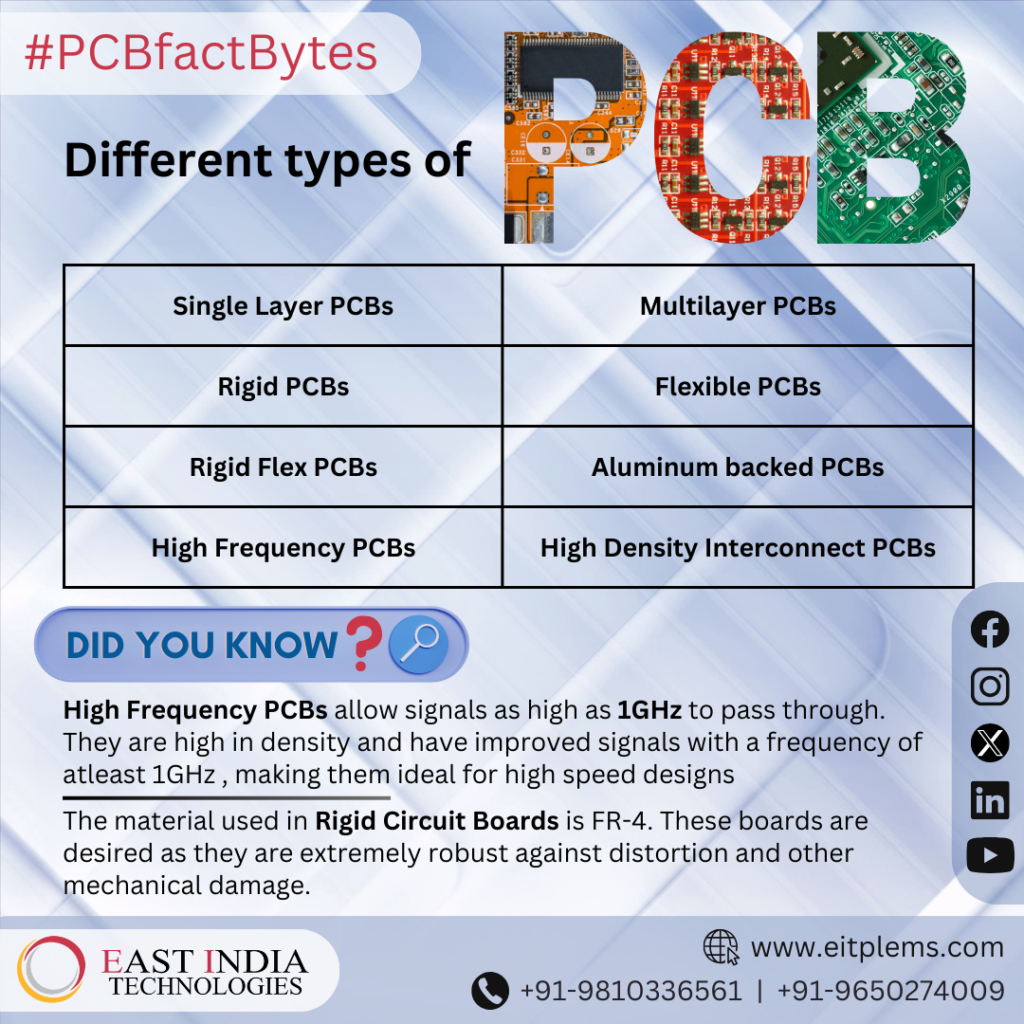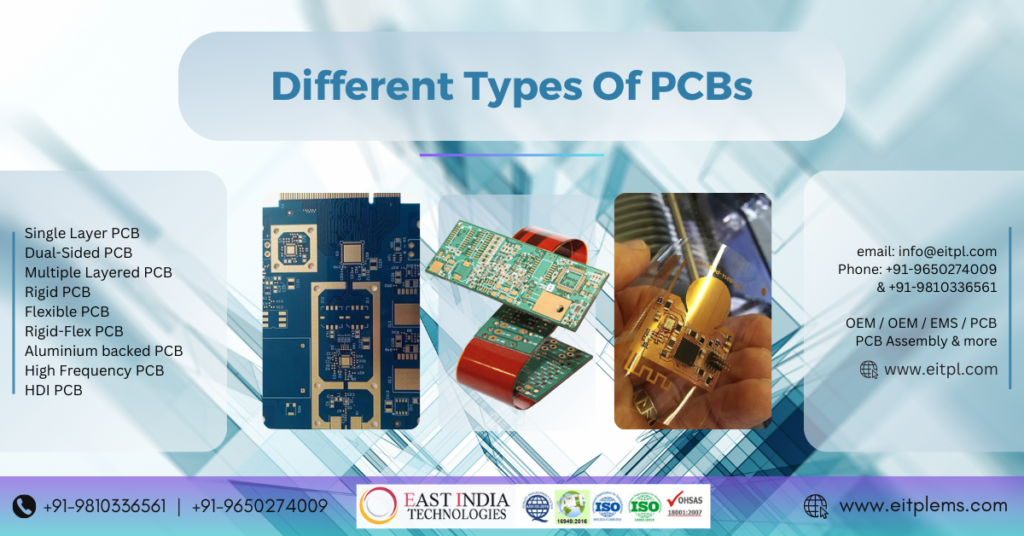PCBs are the heart of any modern electronic device. But are all PCBs similar as they look? Stiff green plates with traces of copper? No. PCBs are of different types & in this article, we will briefly cover different types of PCBs that are popular as of 2023.
An intricate copper track circuitry known as a PCB (Printed Circuit Board) or PWB (Printed Wiring Board) is mounted on a heat-resistant material known as PCB substrate. On this circuit board, electronic components are soldered to regulate the flow of electricity in a predetermined manner so that the electronic gadget operates as intended.
Single Sided PCBs:
Single Sided PCB, often known as a Single Layer PCB, is the most straightforward and reasonably priced printed circuit board. These PCBs only feature one copper layer and one glass layer, which acts as the substrate for the board’s foundation. On one side is the layout for the electronic parts, while on the other is the conductive circuit. It is known as single sided PCB, One Layer PCB, or Single Layer PCB since there is just one conductive layer creating the circuit.
Double Layer PCB aka Double-Sided PCB:
A conductive (copper) layer is present on both sides of the base substrate on a double-sided PCB, also known as a double-layer PCB. The board has a solder mask put on both sides.
Circuits on one side of the PCB can connect to circuits on the other side thanks to conductive holes in the PCB.
Both sides of electronic components are soldered. Both through-hole and Surface Mount Device (SMD) electrical components can be soldered on either side of this type of PCB. Surface Mount Technology enables the soldering of SMD components. Double Sided PCB is the term used to describe a circuit that is formed by two or double conducting layers.
Multilayer PCBs:
A printed circuit board having more than two layers is called a multilayer PCB. These kinds of PCBs must contain a minimum of 3 copper or conductor-filled conducting layers. Copper plated holes link one layer to the next. There might be between four and forty layers.
The top and bottom layers are used to build all of the active and passive electronic components. Every single inner stacked layer is intended for routing. Both through-hole and Surface Mount Device (SMD) electrical components can be soldered on either side of this type of PCB. Surface Mount Technology, along with other PCBA tools may be used to solder SMD components.
Rigid PCB:
All of us are aware that a PCB can be single-sided, double-sided, or multilayered. A PCB can also be a rigid PCB or a Flexible PCB or both rigid and flexible i.e. a rigid-flex (combined rigid and flexible) PCB. Solid & unyielding printed circuit boards are known as rigid PCBs.
Therefore, a rigid circuit board is a PCB that we cannot pull out of shape or bend. Rigid PCBs could be single-sided, double-sided, or multilayer rigid PCBs. A rigid circuit board cannot be altered or folded into a different form after it has been created.
Flexible Printed Circuit Board aka Flex PCB:
Other names for Flex PCB include Flexible PCB, Flex FPC, Flex circuit, Flex Print, and Flexi Circuits. These Flex PCBs are, as their name implies, flexible, foldable, and less rigid than Rigid PCB. These types of PCB may be handled and transported with ease and without any harm because of their flexible material and form. Flex PCBs come in single-sided, double-sided, and multilayer varieties.
A flexible plastic (thin insulating polymer sheet), polyimide, a related polymer, or Kapton are used as the substrate for flexible boards.
This substrate is printed with conductive copper circuitry, and to protect the circuits, a thin polymer covering is used. There are component layouts for the copper rails. Usually, the SMD Components are soldered on a Flexible PCB using Surface Mount Technology (SMT).
Did you Know?
Currently (as of 2023), the longest PCB in the world is 72 meters in length. It is a flexible one.

Rigid Flex Printed Circuit Board:
A rigid flex PCB combines rigid and flexible components. A stiff printed circuit board is attached to a flexible printed circuit board in its most basic form.
Flexible and stiff substrates are laminated to create a single circuit board in a rigid flex printed circuit board. Plated through holes (PTH) are used to join rigid flex circuit boards that are double sided or multilayered.
High Frequency PCBs:
Either very high frequencies or extremely quick switching rates are used in high frequency electronics. In order to ensure that the signals you are trying to send through the PCB are received properly, high frequency PCBs (which are PCBs built for certain purposes) need unique approaches.
Manufacturing of High Frequency PCBs is tied to the design process. The design of HF-PCBs enable the transmission of signals up to 1GHz. Controlled impedance with extra capabilities and some laminate materials may be needed for these kind of PCBs.
HDI PCBs:
These kinds of printed circuit boards (PCBs) are manufactured using precision-based technologies to cram as much functionality as possible into a restricted area. Many conductive layers and cutting-edge laminate materials all aid in this process. The difficulty of routing with high-pin-count chips and other tiny components is supported by HDI PCBs. They feature larger connection pad density and smaller capture pads. Manufacturing HDI PCB is labor-intensive and time-consuming.
Aluminum backed PCBs:
Aluminum backed PCBs are used to support large electrical components, such as the transformers in power supplies. These PCBs contain copper and aluminum plates on both sides.
These are effective in high power applications, and their aluminum construction promotes heat dissipation. Aluminum-backed PCBs are perfect for use cases requiring great mechanical tolerance since they have high levels of rigidity and low levels of thermal expansion. They are utilized for power supply and LEDs too.

Conclusion:
These were some of the different types of PCBs available in the market as of 2023.
Also, when it comes to different kinds of materials that are used to make the base of PCBs, some of those materials are Resin-based, fiberglass-based, epoxy-glass, metal-board, and flame-retardant (UL94-VO, UL94-V1).
With more advancements in technologies, more innovations could lead to more different kinds of PCBs emerging.
If you are looking for SMT, PCB assembly services, PCB Prototyping, OEM, ODM, EMS, etc, then reach out to us at info@eitpl.com . We are East India Technologies Pvt Ltd, a leading EMS company in India.

